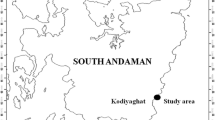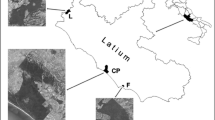Abstract
In the summer of 1994, floodplain habitats of the Atchafalaya River Basin were surveyed for cladocera and copepoda. Collection sites were grouped into three distinct habitat types (black-water, brown-water and green-water) based on a principal components analysis of five hydrographic variables (current velocity, Secchi disk depth, surface percent saturation of dissolved oxygen, dissolved oxygen differential and surface water temperature). An ANOVA of four community indices (total abundance, Shannon–Weiner diversity (H'), richness, and evenness) was performed on both cladoceran and copepod communities among the three floodplain habitats. Common species were compared among habitats (χ2 goodness-of-fit) to determine where they were most abundant. Green-water habitats had the greatest overall abundance of cladocerans and copepods (dominated by Diaphanosoma birgei, Moina micrura and Mesocyclops edax), but ranked lower in diversity and evenness than black-water and brown-water habitats where Ilyocryptus spinifer, Simocephalus serrulatus, Macrocyclops albidus (black-water) and Bosmina longirostris and Acanthocyclops vernalis (brown-water) were most abundant, respectively. These results indicate that the mosaic of floodplain habitats within large temperate river systems support unique zooplankton communities, and that these habitats are largely a function of seasonal hydrographic features.
Similar content being viewed by others
References
Bayley, P. B., 1995. Understanding large river-floodplain ecosystems. Bioscience 45, 153–158.
Binford, M. W., 1978. Copepoda and Cladocera communities in a river-swamp system. Verh. int. Ver. Limnol. 20: 2524–2530.
Bryan, C. F., F. M. Truesdale & D. S. Sabins, 1975. A limnological survey of the Atchafalaya Basin, 1975 Annual Report. Louisiana State University, Baton Rouge.
Bryan, C. F., F. M. Truesdale, D. S. Sabins & J. P. Newman Jr., 1976. A limnological survey of the Atchafalaya Basin, 1976 Annual report. Louisiana State University, Baton Rouge.
Bryan, C. F. & D. S. Sabins, 1979. Management implications in water quality and fish standing stock information in the Atchafalaya River Basin, Louisiana. In Day, J. W. Jr., D. D. Culley Jr., R. E. Turner & A. J. Mumphrey Jr. (eds), Proceedings of the Third Coastal Marsh and Estuary Management Symposium. Louisiana State University Division of Continuing Education, Baton Rouge.
Bryan, C. F., D. A. Rutherford & B. Walker-Bryan, 1992. Acidification of the lower Mississippi River. Trans. am. Fish. Soc. 121: 369–377.
Davidson, N. L. Jr., 1996. Physicochemical relationships with the abundance and distribution of crustacean zooplankton in the Atchafalaya River Basin. Louisiana State University, Baton Rouge. Thesis.
Davidson, N. L. Jr. & W. E. Kelso, 1997. The exotic daphnid, Daphnia lumholtzi, in a Louisiana river-swamp. J. Freshwat. Ecol. 12: 431–435.
Davidson, N. L. Jr., M. C. Griffin & W. E. Kelso, 1997. A report of Bunops scutifrons from Louisiana. Hydrobiologia 356: 183–184.
Davidson, N. L. Jr., W. E. Kelso & D. A. Rutherford, 1998. Relationships between environmental variables and the abundance of cladocerans and copepods in the Atchafalaya River Basin. Hydrobiologia 379: 175–181.
Dodson, S. I., 1992. Predicting crustacean zooplankton species richness. Limnol. Oceanogr. 37: 848–856.
Fremling, C. R., J. L. Rasmussen, R. E. Sparks, S. P. Cobb, C. F. Bryan & T. O. Claflin, 1989. Mississippi River fisheries: a case history. In Dodge, D. P. (ed.), Proceedings of the International Large River Symposium. Can. Spec. Publ. Fish. aquat. Sci. 106: 309-351.
Freund, R. J. & W. J. Wilson, 1997. Statistical methods, revised edition. Academic Press, Inc., San Diego.
Gelwicks, K. R., 1996. Physicochemical influences on the distribution and abundance of fishes of the Atchafalaya River Basin, Louisiana. Louisiana State University, Baton Rouge. Thesis.
Greenberg, A. E., 1964. Plankton of the Sacramento River. Ecology 45: 40–49.
Holland, L. E., C. F. Bryan & J. P. Newman, Jr., 1983. Water quality and the rotifer populations in the Atchafalaya River Basin, Louisiana. Hydrobiologia 98: 55–69.
Iseri, K. T. & W. B. Langbein, 1974. Large rivers of the United States. U. S. Geological Survey Circular 686. 107
Johnson, B. L., W. B. Richardson & T. J. Naimo, 1995. Past, present, and future concepts in large river ecology. Bioscience 45: 134–141.
Junk, W. J., P. B. Bayley & R. E. Sparks, 1989. The flood-pulse concept in river-floodplain systems. In Dodge, D. P. (ed.), Proceedings of the International Large River Symposium. Can. Spec. Publ. Fish. aquat. Sci. 106: 110-127.
Kobayashi, T., R. J. Shiel, P. Gibbs & P. I. Dixon, 1998. Freshwater zooplankton in the Hawkesbury-Nepean River: comparison of community structure with other rivers. Hydrobiologia 377: 133–145.
Lambou, V. W., 1990. Importance of bottomland hardwood forest zones to fishes and fisheries: the Atchafalaya Basin, a case history. In Gosselink, J. G., L. C. Lee & T. A. Muir (eds), Ecological Processes and Cumulative Impacts: Illustrated by bottomland hardwood wetland ecosystems. Lewis Publishers, Inc. Chelsea, Michigan.
Magurran, A. E., 1988. Ecological Diversity and its Measurement. Princeton University Press, Princeton.
Meyer, J. L., 1990. A blackwater perspective on riverine ecosystems. Bioscience 40: 643–651.
Neu, C. W., C. R. Byers & J. M. Peek, 1974. A technique for analysis of utilization-availability data. J. Wildl. Manage. 38: 541–545.
Pace, M. L., S. E. G. Findlay & D. Lints, 1992. Zooplankton in advective environments: the Hudson River community and a comparative analysis. Can. J. Fish. aquat. Sci. 49: 1060–1069.
Porter, K. G., 1977. The plant-animal interface in freshwater ecosystems. Am. Sci. 65: 159–170.
Reid, J. W. & G. G. Marten, 1995. The cyclopoid copepod (Crustacea) fauna of non-planktonic continental habitats in Louisiana and Mississippi. Tul. stud. Zool. Bot. 30: 39–45.
Sager, D. R. & C. F. Bryan, 1981. Temporal and spatial distribution of phytoplankton in the lower Atchafalaya River Basin, Louisiana. In Bryan, C. F. (ed.), Warm-Water Streams Symposium. American Fisheries Society, Bethesda, Maryland.
SAS Institute, Inc., 1989. SAS/STAT guide for personal computers, version 6, 4th edn. SAS Institute, Inc., Cary, North Carolina.
Saunders, J. F., III & W. M. Lewis, Jr., 1988. Zooplankton abundance in the Caura River, Venezuela. Biotropica 20: 206–214.
Shiel, R. J., K. F. Walker & W. D. Williams, 1982. Plankton of the lower River Murray, South Australia. Aust. J. mar. Freshwat. Res. 33: 210–227.
Shiel, R. J. & K. F. Walker, 1984. Zooplankton of regulated and unregulated rivers: the Murray-Darling system, Australia. In Lillehammer, A. & S. J. Saltviet (eds), Regulated Rivers. Univ. of Oslo Press, Oslo.
Stoekel, J. A., L. Camlin, K. D. Blodgett & R. E. Sparks, 1996. Establishment of Daphnia lumholtzi (an exotic zooplankter) in the Illinois River. J. Freshwat. Ecol. 11: 377–379.
Tafe, D. J., 1990. Zooplankton and salinity in the Rufiji River delta, Tanzania. Hydrobiologia 208: 123–130.
Toft, C. A. & P. J. Shea, 1983. Detecting community-wide patterns: estimating power strengthens statistical inference. Am. Nat. 122: 618–625.
Vannote, R. L., G. W. Minshall, K. W. Cummins, J. R. Sedell & C. E. Cushing, 1980. The river continuum concept. Can. J. Fish. aquat. Sci. 37: 130–137.
Author information
Authors and Affiliations
Rights and permissions
About this article
Cite this article
Davidson, N.L., Kelso, W.E. & Rutherford, D.A. Characteristics of cladoceran and copepod communities in floodplain habitats of the Atchafalaya River Basin. Hydrobiologia 435, 99–107 (2000). https://doi.org/10.1023/A:1004064806352
Issue Date:
DOI: https://doi.org/10.1023/A:1004064806352




